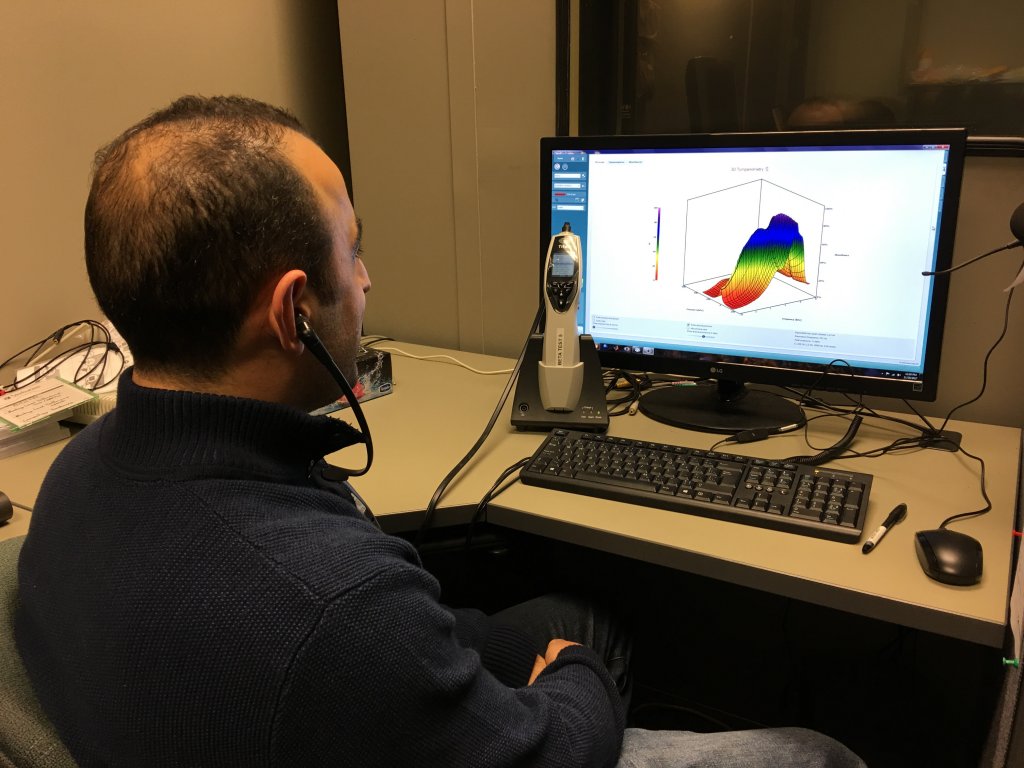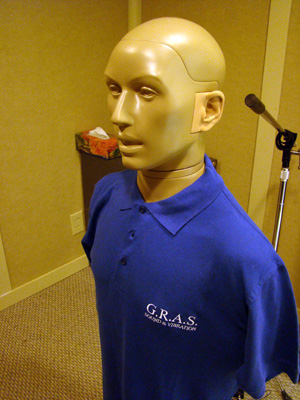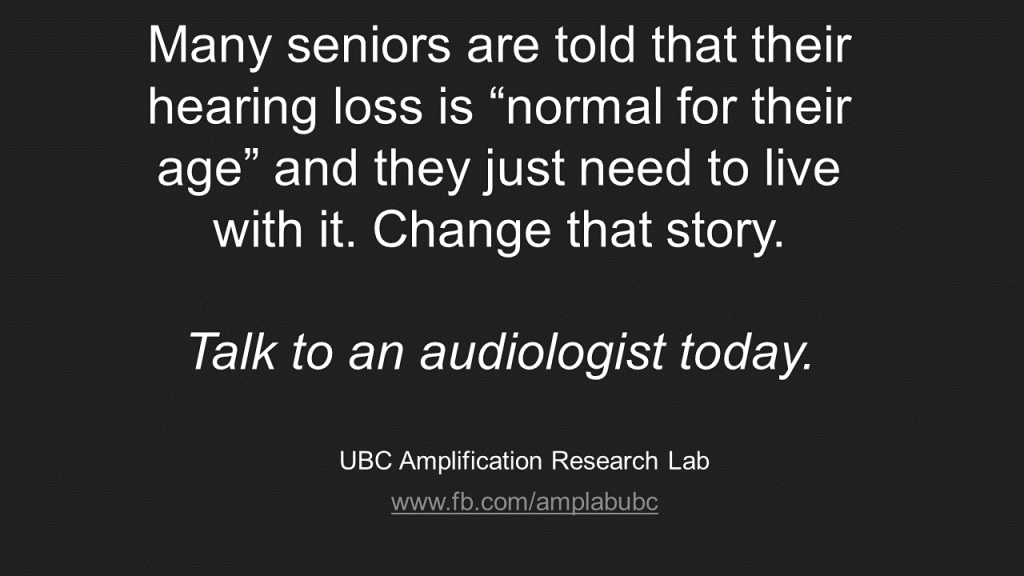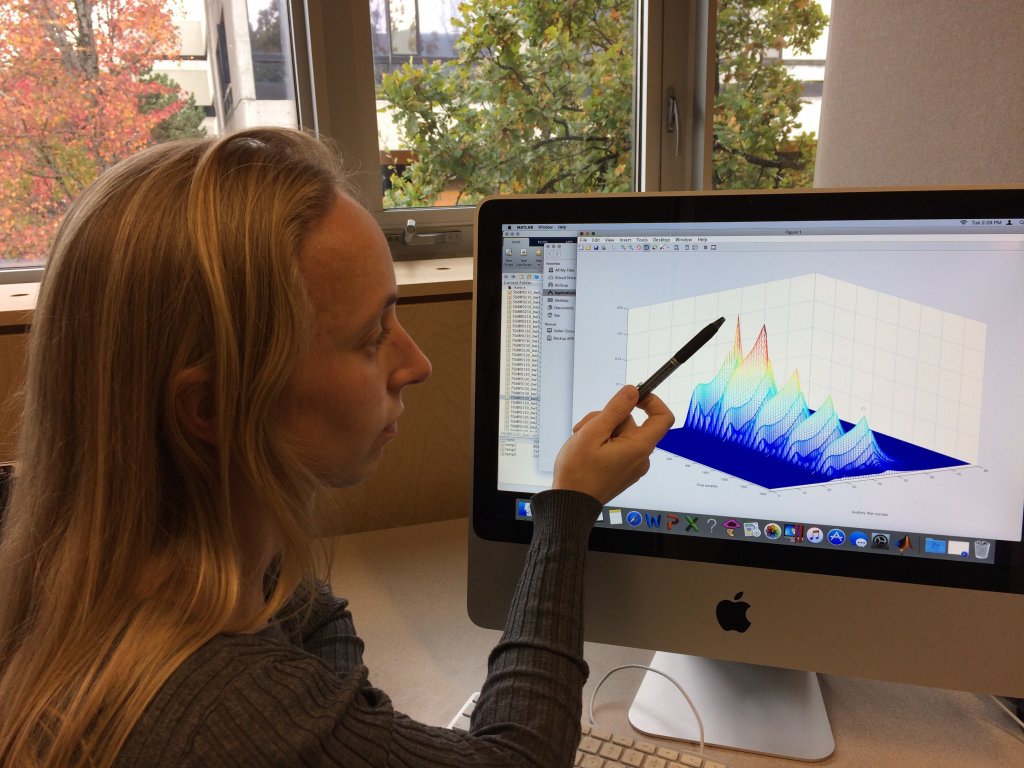Overview of the School of Audiology and Speech Sciences
The School of Audiology and Speech Sciences (SASS) in the Faculty of Medicine at the University of British Columbia (UBC) is the only program in British Columbia that educates speech-language pathologists and audiologists. The school provides graduate education (MSc and PhD degrees) for students preparing for clinical and/or academic careers in Speech-Language Pathology or Speech and Language Sciences, and Audiology or Hearing Science. The academic component is enhanced by externships: real-life experience in the field, where students learn and work alongside practitioners. State-of-the-art teaching labs, research, and study areas create an ideal learning space, while the city of Vancouver provides an enjoyable and beautiful locale.
Audiology Research at SASS
Audiology faculty at SASS are engaged in research in many areas of human communication and its disorders. Research is conducted in well-equipped university laboratories, and in hospitals and clinical settings in the community. There are 5 active research labs in audiology: Amplification Research Lab directed by Dr. Lorienne Jenstad; Auditory Perception and Speech Lab directed by Dr. Valter Ciocca; BRANE Lab, directed by Dr. Anthony Herdman; Middle Ear Lab directed by Dr. Navid Shahnaz, and Pediatric Audiology Lab directed by Dr. Susan Small. In this report, we are highlighting the research activities of 3 labs.
Current Research Projects in the Middle-Ear Lab (MEL)

The Middle-Ear-Lab research team. Dr Navid Shanaz, PhD, Aud(C), Director, Ainsley Ma, MSc Student in Audiology, Shahab Ravanparast, MA, Charlene Chang, MSc Student in Audiology, Lareina Abbott, MSc candidate in Audiology, Esther Rhi, Chamutal Efrat, visiting MSc candidate in Audiology, Martine Schlagintweit, MSc candidate in Audiology, Samaneh Yekta, MSc in Audiology.
Here are some new research themes in which MEL is engaged:
Development of Test Protocol for Identifying Hidden Hearing Loss
There is evidence that listeners with a history of noise exposure but with normal audiograms have deficits in speech perception and temporal processing. Similarly, the aging process may affect speech perception in noise even when there are no significant increases in the audiometric threshold, and this may be related to a deterioration in temporal processing. Difficulty hearing in noise, tinnitus, and hyperacusis have all been reported in noise-exposed human ears with normal behavioural thresholds. This condition, which is also called hidden hearing loss (HHL), may also be key to the origin of other perceptual anomalies associated with noise damage and aging, including hyperacusis and tinnitus which may arise via an initiation of central gain adjustment secondary to loss of afferent input to the auditory central nervous system - CNS. The major goal of the proposed study is to understand the effect of age, noise exposure, tinnitus/hyperacusis and ethnicity on extended high-frequency audiometry, central auditory processing, and middle-ear transmission properties in the elderly group.
Translational Research in the Application of Wideband Acoustic Immittance (WAI) in the Clinical Practice
WAI is not a new procedure but rather an improvement of the measurement technique in the characterization of normal and diseased middle ear function across much wider frequency range than conventional tympanometry. To this end, we have established instrument, ethnic, age, and gender-specific norms for WAI parameters at ambient and tympanometric peak pressure. The outcome of these norms in creating a diagnostic profiling of otosclerotic ears, middle ear effusion, and other middle ear pathologies are being investigated. Recently we have looked at the impact of a cochlear implant in changing the middle ear mechano-acoustical properties in the adult population. We are also using WAI in the development of a novel newborn hearing screening protocol. This would enable us to develop a newborn hearing screening protocol that could also identify the type of hearing loss at the time of screening.
Effects of Middle Ear Pressure Compensation on Evoked Otoacoustic Emission and Power Absorbance in Adults
Rae Riddler, MSc in audiology investigated the effect of positive and negative middle ear pressure (MEP) on evoked otoacoustic emissions (EOAEs) both distortion-product OAEs (1.5 to 8 kHz), transient evoked OAEs (1 to 5 kHz), and wideband acoustic immittance measures of power absorbance (PA) in a normal-hearing young adult population. Results of her study suggest clinical benefit for a more accurate assessment of middle ear status and cochlear integrity for patients with abnormal MEP when EOAE are assessed at a compensated pressure level.
Current Projects in the Amplification Research Lab
Research in the AmpLab centres around two general themes: (1) Hearing aid processing; and (2) Hearing health for older adults.
Hearing Aid Processing
In the first theme, we conduct studies measuring the acoustic effects of hearing aid processing on speech and other signals of interest. Then we examine whether these acoustic changes have any effects behaviourally (e.g., speech recognition, quality, preference) or electrophysiologically.
One example of a study in this first theme is the doctoral work recently completed by Dr. Foong Yen Chong, who is now on faculty in Malaysia. Foong Yen did a comprehensive analysis of the effects of digital noise reduction in hearing aids on fricatives in both English and Mandarin. She showed that while noise reduction, as implemented in some hearing aids, reduces the intensity of important speech cues to the identity of fricatives, these acoustic changes did not affect the ability of listeners to identify those sounds or to learn novel speech sounds. Her finding confirms that noise reduction is unlikely to be harmful to learning of speech and language.1

Figure 1. The Knowles Electronics Manikin for Acoustic Research (KEMAR) is a permanent lab resident. He often lends his ears to make recordings of hearing aid processing at the ear drum.
A second example of a study in this theme is work done by Master’s students Myron Huen and Kelsey Meagher. Myron Huen undertook a thorough investigation of how hearing aid processing can affect the signals that are used in electrophysiological testing. She found significant effects; for example, hearing aids can greatly elongate the rise time of pure tone signals, which has implications for the brain wave responses to these signals. Kelsey Meagher performed cortical auditory evoked potential (CAEP) tests of those altered signals and confirmed that they did indeed alter the amplitude of the brain’s response, leading to the conclusion that further work is needed before it is possible to validate hearing aid performance via electrophysiological measures.
Hearing Health for Older Adults.
In the second broad research theme, we often collaborate with researchers and clinicians from multiple disciplines to examine questions regarding the process an individual may go through in the pursuit of hearing health. We have asked questions about barriers and facilitators to older adults seeking help for hearing loss or obtaining hearing aids.2 We have also considered ways to take an interprofessional and interdisciplinary approach to improve access to hearing health care. As Figure 2 shows, we have encountered some messaging that might inhibit seniors from seeking help. We are actively trying to disseminate counter messages that would encourage older adults to seek out hearing health care for themselves.

Figure 2. Our attempt to counter the negative messaging that seniors might receive from physicians, family, or friends.
One of the exciting projects within this theme is a coalition between the Canadian Academy of Audiology and Speech-Language Audiology Canada. The Canadian Coalition on Adult Hearing Health is a group of clinicians and researchers representing both CAA and SAC. The premise that started this group is: "Many adults who could benefit from hearing healthcare are not pursuing or receiving sufficient services" and our initial efforts have been focused on finding solutions to that problem. We started by interviewing researchers, consumers, and clinicians. Initial data analysis suggests some interesting directions we can take. Over the next few months, we will release our findings from the interview process and define some specific initiatives that the coalition can work on together.
A second exciting project is a scoping review of the literature to determine whether communication interaction between healthcare providers and patients is associated with health outcomes or treatment compliance. This project is not specific to audiology and is being conducted together with researchers from linguistics, speech-language pathology, and related medical and communication fields. We look forward to finding out what we can learn broadly about best communication practices that will encourage patients or clients to adhere to recommendations made by their clinicians. For an audiology example refer to Ekberg et al.3
Two Current Projects in the Auditory Perception and Speech Lab
Exploring how the Brain Generates Auditory Events
The project is an investigation of the heuristic rules that the brain uses in order to generate multiple, distinct auditory events when several sound sources are active at the same time. Consider the situation in which a loud noise (for example, a door being slammed) temporarily masks a softer sound (for example, a spoken sentence). In this situation, listeners typically hear a complete sentence "underneath" the louder noise. This phenomenon shows that the auditory system "joins" the part of the sentence that preceded the noise (pre-noise signal) with the part of the sentence following the noise (post-noise signal) by perceptually synthesizing the missing (masked) part of the sentence. In our lab, we have been investigating the perceived continuity of a soft signal that is interrupted by a loud masker by testing cochlear implant listeners, as well as listeners without a hearing loss. We have also been investigating the characteristics of the masker and of the pre- and post-noise signals that facilitate (or disrupt) the perception of a continuous signal. This research project will improve our knowledge about the perception of interrupted/masked sounds by listeners with and without a hearing loss. This research has implications for the implementation of processing strategies that will improve the recognition of sounds in noisy listening environments by users of hearing aids and cochlear implants.4,5
Perception of Noise in Vowels and Vowel-Like Sounds PhD student Ilse Labuschagne reviewing the output of a physiological model of auditory processing,6 displaying the simulated basilar membrane motion produced by one of her experimental stimuli.

PhD student Ilse Labuschagne has been investigating how listeners attribute a "noisy" quality to speech sounds such as vowels. For example, talkers vary in the degree to which their speech sounds "breathy"; breathiness is associated with the presence of noise in the acoustic signal and can be indicative of a voice pathology. This study has been using various methodological approaches including: (1) the acoustic analysis of natural and synthesized vowels and vowel-like sounds; (2) psychoacoustic experiments in which listeners are asked to detect or discriminate stimuli with various degrees of noisiness; and (3) the use of physiologically-based computational models of auditory processing. A key goal of this research is to improve our understanding of how the auditory system processes noise within sounds of interest, and to learn how the presence of noise affects the quality of the sounds we hear. The achievement of this goal has implications for the design of sound processing strategies in hearing aids and implantable hearing devices.7,8
References
- Chong FY, Jenstad LM. Digital noise reduction and its acoustic effect on consonants /s/ and /z/. [Abstract]. Proceedings of The International Symposium of Health Sciences 2017. Med J Malaysia 2017;72(S2):53.
- Holliday H, Jenstad LM, Purves B, Grosjean G. “You can lead a horse to water…”: Focus group perspectives on initiating and supporting hearing health change in older adults. American Journal of Audiology 2015;24(3):360–76.
- Ekberg K, Grenness C, and Hickson L. Addressing patients’ psychosocial concerns regarding hearing aids within audiology appointments for older adults. Am J Audiol 2014;23:337–50.
- Haywood NR, Chang I-Chu J, and Ciocca V. Perceived tonal continuity through two noise bursts separated by silence. J Acoust Soc Am 2011;130:1503–14.
- Ciocca V. and Haywood NR. Boundary effects on the illusory continuity of and interrupted glide through a notched noise. The Journal of the Acoustical Society of America 2013;133:3286.
https://doi.org/10.1121/1.4805395 - Patterson RD, Allerhand MH, and Giguere C, Time-domain modeling of peripheral auditory processing: a modular architecture and a software platform. J Acoust Soc Am 1995 Oct;98(4):1890–4.
1995 - Labuschagne I. and Ciocca, V. The perception of breathiness: Acoustic correlates and the influence of methodological factors. J Acoust Soc Japan/Acoust Sci Technol 2016;37(5):191–201.
- Labuschagne I. and Ciocca V. Discrimination of aspiration noise in breathy vowels. Can Acoust 2016;44(3)218–19.


